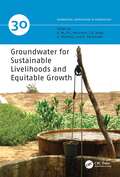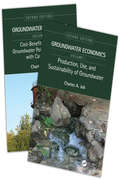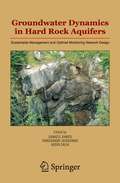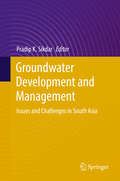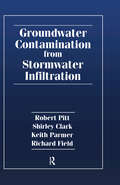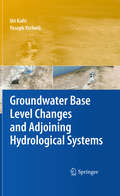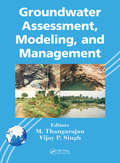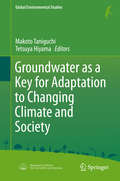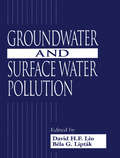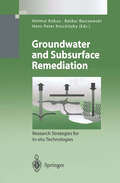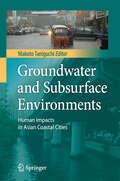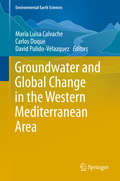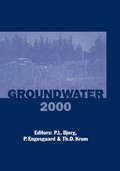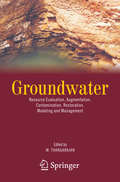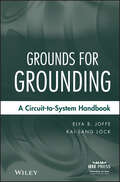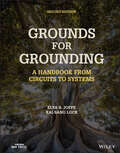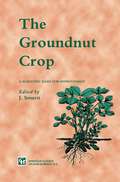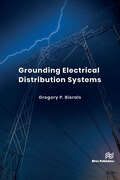- Table View
- List View
Groundwater for Sustainable Livelihoods and Equitable Growth (IAH - International Contributions to Hydrogeology #30)
by Viviana Re Rodrigo Lilla Manzione Tamiru A. Abiye Aditi Mukherji Alan MacDonaldGroundwater for Sustainable Livelihoods and Equitable Growth explores how groundwater, often invisibly, improves peoples’ lives and livelihoods. This unique collection of 19 studies captures experiences of groundwater making a difference in 16 countries in Africa, South America and Asia. Such studies are rarely documented and this book provides a rich new collection of interdisciplinary analysis. The book is published in colour and includes many original diagrams and photographs. Spring water, wells or boreholes have provided safe drinking water and reliable water for irrigation or industry for millennia. However, the hidden nature of groundwater often means that it’s important role both historically and in the present is overlooked. This collection helps fill this knowledge gap, providing a diverse set of new studies encompassing different perspectives and geographies. Different interdisciplinary methodologies are described that can help understand linkages between groundwater, livelihoods and growth, and how these links can be threatened by over-use, contamination, and ignorance. Written for a worldwide audience of practitioners, academics and students with backgrounds in geology, engineering or environmental sciences; Groundwater for Sustainable Livelihoods and Equitable Growth is essential reading for those involved in groundwater and international development.
Groundwater Economics, Two-Volume Set
by Charles A. JobGroundwater is a vitally important resource and as its use increases, the available supply is depleted, creating a ripple effect of impacts on both the environment and the economy that need to be disseminated to a larger audience of students and practitioners. This second edition of Groundwater Economics accomplishes just that. This two-volume set is a comprehensive work focused on the economic values of groundwater resources and use, and it reinforces the need for a strong economic rationale in decision-making relating to that use. This new edition includes a new chapter on sustainability as well as updating all chapters with a focus on sustainability. It thoroughly explains the economic value of groundwater for sustainable use and needs, with practical examples, and includes thirteen new and updated case studies on the economics of groundwater data for decision-making. It also addresses both local and regional groundwater economic choices through a series of applications at an international level. This set, written by a sustainability professional with decades of experience in managing groundwater use and protection, is written for other professionals as well as students, who need to understand and evaluate water resources and mange their use from a variety of sustainable approaches.
Groundwater Dynamics in Hard Rock Aquifers: Sustainable Management and Optimal Monitoring Network Design
by Shakeel Ahmed Ramaswamy Jayakumar Abdin SalihThis book contains the results and findings of the advanced research carried out in a pilot area with a thorough investigation of the structure and functioning of an aquifer in a granitic formation. It characterizes the hard rock aquifer system and examines its properties and behavior as well as systematically details the geophysical, geological and remote sensing applications to conceptualize such an aquifer system.
Groundwater Development and Management: Issues and Challenges in South Asia
by Pradip K. SikdarThis book deals with the challenges for efficient groundwater management, with a focus on South Asia and India, providing a balanced presentation of theory and field practice using a multidisciplinary approach. Groundwater of South Asia is increasingly confronted with overuse and deteriorating quality and therefore requires urgent attention. Management of the stressed groundwater systems is an extremely complex proposition because of the intricate hydrogeological set-up of the region. Strategies for sustainable management must involve a combination of supply-side and demand-side measures depending on the regional setting and socio-economic situations. As a consequence, the challenges of efficient groundwater management require not only a clear understanding of the aquifer configuration, but also demand for the development of a comprehensive database of the groundwater occurrences and flow systems in each hydrogeological setting. In addition, drilling and well construction methods that are appropriate to different hydrogeological formations need to be implemented as well as real-time monitoring of the status of the groundwater use. Also corrective measures for groundwater that is threatened with depletion and quality deterioration need to be installed. Finally, the legal framework of groundwater needs to be rearticulated according to the common property aspect of groundwater. These challenges should revolve around effective groundwater governance by creating an atmosphere to support and empower community-based systems of decision-making and revisit the existing legal framework and groundwater management institutions by fostering community initiatives.This book is relevant for academics, professionals, administrators, policy makers, and economists concerned with various aspects of groundwater science and management.
Groundwater Contamination from Stormwater Infiltration
by Robert E. Pitt Shirley Clark Keith Parmer Richard FieldGroundwater Contamination from Stormwater Infiltration examines topics such as urban runoff, constituents of concern, treatment, combined sewage characteristics, relative contributions of urban runoff flow phase, salts and dissolved minerals, treatment before discharge, outfall pretreatment, and local pretreatment.
Groundwater Contamination from Stormwater Infiltration
by Robert E. Pitt Shirley Clark Keith Parmer Richard FieldGroundwater Contamination from Stormwater Infiltration examines topics such as urban runoff, constituents of concern, treatment, combined sewage characteristics, relative contributions of urban runoff flow phase, salts and dissolved minerals, treatment before discharge, outfall pretreatment, and local pretreatment.
Groundwater Base Level Changes and Adjoining Hydrological Systems
by Uri Kafri Yoseph YechieliThe proposed book deals with the role of changing groundwater base level on the adjacent hydrological systems. It summarizes, compiles and compares results of current and paleo base levels, using examples from all over the world. A classification is given for marine or continental groundwater base levels with special attention to those below sea level. The factors controlling base level changes and the methods for their determination are elaborated. Holocene and future changes are discussed with their effect on salinization and flushing mechanisms of groundwater. All topics described in the book are accompanied by examples and references from all over the world.
Groundwater Assessment, Modeling, and Management
by M. Thangarajan Vijay P. SinghYour Guide to Effective Groundwater Management Groundwater Assessment, Modeling, and Management discusses a variety of groundwater problems and outlines the solutions needed to sustain surface and ground water resources on a global scale. Contributors from around the world lend their expertise and provide an international perspective on groundwater management. They address the management of groundwater resources and pollution, waste water treatment methods, and the impact of climate change on groundwater and water availability (specifically in arid and semi-arid regions such as India and Africa). Incorporating management with science and modeling, the book covers all areas of groundwater resource assessment, modeling, and management, and combines hands-on applications with relevant theory. For Water Resource Managers and Decision Makers The book describes techniques for the assessment of groundwater potential, pollution, prevention, and remedial measures, and includes a new approach for groundwater modeling based on connections (network theory). Approximately 30 case studies and six hypothetical studies are introduced reflecting a range of themes that include: groundwater basics and the derivation of groundwater flow equations, exploration and assessment, aquifer parameterization, augmentation of aquifer, water and environment, water and agriculture, the role of models and their application, and water management policies and issues. The book describes remote sensing (RS) applications, geographical information systems (GIS), and electrical resistivity methods to delineate groundwater potential zones. It also takes a look at: Inverse modeling (pilot-points method) Simulation optimization models Radionuclide migration studies through mass transport modeling Modeling for mapping groundwater potential Modeling for vertical 2-D and 3-D groundwater flow Groundwater Assessment, Modeling, and Management explores the management of water resources and the impact of climate change on groundwater. Expert contributors provide practical information on hydrologic engineering and groundwater resources management for students, researchers, scientists, and other practicing professionals in environmental engineering, hydrogeology, irrigation, geophysics, and environmental science.
Groundwater Assessment, Modeling, and Management
by M. Thangarajan Vijay P. SinghYour Guide to Effective Groundwater Management Groundwater Assessment, Modeling, and Management discusses a variety of groundwater problems and outlines the solutions needed to sustain surface and ground water resources on a global scale. Contributors from around the world lend their expertise and provide an international perspective on groundwater management. They address the management of groundwater resources and pollution, waste water treatment methods, and the impact of climate change on groundwater and water availability (specifically in arid and semi-arid regions such as India and Africa). Incorporating management with science and modeling, the book covers all areas of groundwater resource assessment, modeling, and management, and combines hands-on applications with relevant theory. For Water Resource Managers and Decision Makers The book describes techniques for the assessment of groundwater potential, pollution, prevention, and remedial measures, and includes a new approach for groundwater modeling based on connections (network theory). Approximately 30 case studies and six hypothetical studies are introduced reflecting a range of themes that include: groundwater basics and the derivation of groundwater flow equations, exploration and assessment, aquifer parameterization, augmentation of aquifer, water and environment, water and agriculture, the role of models and their application, and water management policies and issues. The book describes remote sensing (RS) applications, geographical information systems (GIS), and electrical resistivity methods to delineate groundwater potential zones. It also takes a look at: Inverse modeling (pilot-points method) Simulation optimization models Radionuclide migration studies through mass transport modeling Modeling for mapping groundwater potential Modeling for vertical 2-D and 3-D groundwater flow Groundwater Assessment, Modeling, and Management explores the management of water resources and the impact of climate change on groundwater. Expert contributors provide practical information on hydrologic engineering and groundwater resources management for students, researchers, scientists, and other practicing professionals in environmental engineering, hydrogeology, irrigation, geophysics, and environmental science.
Groundwater as a Key for Adaptation to Changing Climate and Society (Global Environmental Studies)
by Makoto Taniguchi Tetsuya HiyamaThe book presents an overview of recent advances in knowledge related to the assessment and management of groundwater resources, giving special attention to the uncertainties related to climate change and variability. While proposing strategies of groundwater management as adaptation, alternative and resilience under the changing environments, this book also discusses new directions and initiatives of hydrological study, in particular on the groundwater. Groundwater is a major source of water across much of the world, and acts as a component of the global water cycle on the Earth. Groundwater has the capacity to balance large swings in precipitation and has the potential to supplement surface-water resources when they are close to the limits of sustainability such as during drought. Although groundwater is pivotal to sustain water supplies, these important resources are vulnerable to increased human activities and the uncertain consequences of climate change. This book presents that groundwater with longer resident time of water circulation can be an alternative water resources and environment in changing climate. Assessments of groundwater services and benefit as well as risk are important for sustainable groundwater uses under the climate change. Groundwater which is one of the leys of adaptation to climate change should be treated as common resources and environment beyond the tragedy of the commons and dilemma of the boundaries. While providing a comprehensive description of hydrogeological characteristics of groundwater systems, the present volume also covers important aspects of legal and institutional contexts required for groundwater resources management as well as social and economic considerations. This publication may contribute to an improved understanding of the impacts of climate change and human activity on groundwater resources, provides useful guidance for policy makers and planners to include groundwater into climate change adaptation schemes and strategies.
Groundwater and Surface Water Pollution
by David H.F. Liu and Béla G. LiptákGroundwater and Surface Water Pollution contains almost all the technical know-how required to clean up our water supply. It provides a survey of up-to-date technologies for remediation, as well as a step-by-step guide to pollution assessment for both ground and surface waters.The book defines groundwater, aquifers and surface water and discusses the physical properties of soils, liquids, vadose zones and aquifers. It emphasizes controlling nonpoint source pollution, best management practices, and an integrated management approach.The editors cover not only engineering but also legal, medical, agricultural, meteorological, biological and other fields of study. They reach beyond the simplistic hydrological cycles usually addressed to the complexities encountered by rapidly-changing land-use patterns.In addition to focusing on causes, effects, and remedies, Groundwater and Surface Water Pollution stresses reuse, recycling, and recovery of resources. Nature does not cause pollution. Through total recycling, we can, like nature, make resources out of wastes.Béla G. Lipták speaks on Post-Oil Energy Technology on the AT&T Tech Channel.
Groundwater and Surface Water Pollution
by David H. F. Liu Bela G. LiptakGroundwater and Surface Water Pollution contains almost all the technical know-how required to clean up our water supply. It provides a survey of up-to-date technologies for remediation, as well as a step-by-step guide to pollution assessment for both ground and surface waters.The book defines groundwater, aquifers and surface water and discusses the physical properties of soils, liquids, vadose zones and aquifers. It emphasizes controlling nonpoint source pollution, best management practices, and an integrated management approach.The editors cover not only engineering but also legal, medical, agricultural, meteorological, biological and other fields of study. They reach beyond the simplistic hydrological cycles usually addressed to the complexities encountered by rapidly-changing land-use patterns.In addition to focusing on causes, effects, and remedies, Groundwater and Surface Water Pollution stresses reuse, recycling, and recovery of resources. Nature does not cause pollution. Through total recycling, we can, like nature, make resources out of wastes.Béla G. Lipták speaks on Post-Oil Energy Technology on the AT&T Tech Channel.
Groundwater and Subsurface Remediation: Research Strategies for In-situ Technologies (Environmental Science and Engineering)
by Helmut Kobus Baldur Barczewski Hans-Peter KoschitzkyThe complex topic of in-situ subsurface remediation technologies has been ad dressed at an international symposium at the Universitat Stuttgart on September 26 and 27, 1995, on the occasion of the inauguration of the research facility VEGAS (Versuchseinrichtung zur Grundwasser- und Altlastensanierung). The results are contained in this book with 22 contributions from leading experts in the field from Europe and North America. The book illustrates the role of large-scale experiments in groundwater and subsurface remediation research. The subtopics address the various links between conventional laboratory experiments, technology-scale experiments and field-site studies, showing the contribution of large-scale experiments to bridging the gap between small-scale investigations and large-scale field investigations (upscaling). The interdisciplinary nature of the problems requires a multidisciplinary approach. Therefore, the idea has been followed to bring together the various disciplines in volved in the different aspects and facets of subsurface flow, transport and trans as hydraulics and hydrology, physics, formation, involving such diverse disciplines chemistry, microbiology, geology, industrial, chemical and hydraulic engineering, mathematics and hydroinformatics. The individual contributions from these di versified fields address the subject from different angles in an attempt to form a coherent picture of the various aspects of the complex problems of subsurface remediation. The focus is on research approaches and strategies with respect to the development of new and improved technologies and to the role of large-scale experiments in research and application.
Groundwater and Subsurface Environments: Human Impacts in Asian Coastal Cities
by Makoto TaniguchiExcessive groundwater pumping, groundwater contamination, and subsurface thermal anomalies have occurred frequently in Asian coastal cities, greatly disturbing the urban aquifer and the subsurface environment. In this volume, the relationship between the stage of a city’s development and subsurface environment issues have been explored. Intensive field surveys were done in Tokyo, Osaka, Seoul, Taipei, Bangkok, Jakarta, and Manila. New, advanced methods, including satellite, tracer techniques, and the social economy model, were developed to evaluate subsurface conditions. Groundwater storage and groundwater recharge rates, as well as the accumulation and transport of pollutants, have been compiled as integrated indices of natural capacities under climate and social changes, and used to evaluate the vulnerability risk for all cities. The indices have been made on a yearly basis for seven cities for a century (1900–2000). Using these indicators it is now possible to manage groundwater resources in a sustainable fashion. This volume is indispensable to researchers in hydrology, coastal oceanography, civil engineering, urban geography, social economy, climatology, geothermics, and urban management.
Groundwater and Global Change in the Western Mediterranean Area (Environmental Earth Sciences)
by Maria Luisa Calvache Carlos Duque David Pulido-VelazquezThis book is a compilation of papers examining the impacts of global change (GC) on water resources systems. Mainly focusing on groundwater resources in Western Mediterranean countries, it shows that this topic is one of the most important challenges facing society. The papers explore developments in both Southern Europe and North Africa, where major impacts on the sustainability, quantity, quality, and management of water resources are expected to emerge. Although most global change publications focus on surface water, the number of research papers addressing global change and groundwater has grown rapidly in recent years. Continuing that welcome trend, this book gathers the main findings presented at the “Congress on Groundwater and Global Change in the Western Mediterranean” (Granada, Spain, November 6–9, 2017), which brought together researchers and technicians interested in groundwater issues affecting this geographic area.
Groundwater 2000: Proceedings of the International Conference on Groundwater Research, Copenhagen, Denmark, 6-8 June 2000
by Poul L. Bjerg Peter Engesgaard Thomas D. KromThese proceedings, with cd-rom, present a comprehensive overview of advances in groundwater research. The five main topics covered are: aquifers and contaminant distribution; groundwater quality; natural attenuation; remediation technologies and groundwater protection. Groundwater 2000 is a useful resource to both scientists and to those working in the field.
Groundwater 2000: Proceedings of the International Conference on Groundwater Research, Copenhagen, Denmark, 6-8 June 2000
by Poul L. Bjerg Peter Engesgaard Thomas D. KromThese proceedings, with cd-rom, present a comprehensive overview of advances in groundwater research. The five main topics covered are: aquifers and contaminant distribution; groundwater quality; natural attenuation; remediation technologies and groundwater protection. Groundwater 2000 is a useful resource to both scientists and to those working in the field.
Groundwater: Resource Evaluation, Augmentation, Contamination, Restoration, Modeling and Management
by M. ThangarajanThis book provides comprehensive coverage on the assessment and management of groundwater. It contains the work of international experts in the field of groundwater resource evaluation, characterization, augmentation, restoration, modeling and management.
Grounds for Grounding: A Circuit to System Handbook
by Elya B. Joffe Kai-Sang LockGrounding design and installation is critical for the safety and performance of any electrical or electronic system. Blending theory and practice, this is the first book to provide a thorough approach to grounding from circuit to system. It covers: grounding for safety aspects in facilities, lightning, and NEMP; grounding in printed circuit board, cable shields, and enclosure grounding; and applications in fixed and mobile facilities on land, at sea, and in air. It?s an indispensable resource for electrical and electronic engineers concerned with the design of electronic circuits and systems.
Grounds for Grounding: A Circuit to System Handbook
by Elya B. Joffe Kai-Sang LockGrounding design and installation is critical for the safety and performance of any electrical or electronic system. Blending theory and practice, this is the first book to provide a thorough approach to grounding from circuit to system. It covers: grounding for safety aspects in facilities, lightning, and NEMP; grounding in printed circuit board, cable shields, and enclosure grounding; and applications in fixed and mobile facilities on land, at sea, and in air. It?s an indispensable resource for electrical and electronic engineers concerned with the design of electronic circuits and systems.
Grounds for Grounding: A Handbook from Circuits to Systems
by Elya B. Joffe Kai-Sang LockGROUNDS FOR GROUNDING Gain a comprehensive understanding of all aspects of grounding theory and application in this new, expanded edition Grounding design and installation are crucial to ensure the safety and performance of any electrical or electronic system irrespective of size. Successful grounding design requires a thorough familiarity with theory combined with practical experience with real-world systems. Rarely taught in schools due to its complexity, identifying and implementing the appropriate solution to grounding problems is nevertheless a vital skill in the industrial world for any electrical engineer. In Grounds for Grounding, readers will discover a complete and thorough approach to the topic that blends theory and practice to demonstrate that a few rules apply to many applications. The book provides basic concepts of Electromagnetic Compatibility (EMC) that act as the foundation for understanding grounding theory and its applications. Each avenue of grounding is covered in its own chapter, topics from safety aspects in facilities, lightning, and NEMP to printed circuit board, cable shields, and enclosure grounding, and more. Grounds for Grounding readers will also find: Revised and updated information presented in every chapter New chapters on grounding for generators, uninterruptible power sources (UPSs) New appendices including a grounding design checklist, grounding documentation content, and grounding verification procedures Grounds for Grounding is a useful reference for engineers in circuit design, equipment, and systems, as well as power engineers, platform, and facility designers.
Grounds for Grounding: A Handbook from Circuits to Systems
by Elya B. Joffe Kai-Sang LockGROUNDS FOR GROUNDING Gain a comprehensive understanding of all aspects of grounding theory and application in this new, expanded edition Grounding design and installation are crucial to ensure the safety and performance of any electrical or electronic system irrespective of size. Successful grounding design requires a thorough familiarity with theory combined with practical experience with real-world systems. Rarely taught in schools due to its complexity, identifying and implementing the appropriate solution to grounding problems is nevertheless a vital skill in the industrial world for any electrical engineer. In Grounds for Grounding, readers will discover a complete and thorough approach to the topic that blends theory and practice to demonstrate that a few rules apply to many applications. The book provides basic concepts of Electromagnetic Compatibility (EMC) that act as the foundation for understanding grounding theory and its applications. Each avenue of grounding is covered in its own chapter, topics from safety aspects in facilities, lightning, and NEMP to printed circuit board, cable shields, and enclosure grounding, and more. Grounds for Grounding readers will also find: Revised and updated information presented in every chapter New chapters on grounding for generators, uninterruptible power sources (UPSs) New appendices including a grounding design checklist, grounding documentation content, and grounding verification procedures Grounds for Grounding is a useful reference for engineers in circuit design, equipment, and systems, as well as power engineers, platform, and facility designers.
The Groundnut Crop: A scientific basis for improvement
by J. SmarttGroundnuts (peanuts) are of great economic importance internationally. This book provides thorough coverage of all aspects of the crop, each chapter being written by experts in particular areas. The book will be invaluable to all those involved with the group, particularly agronomists, plant scientists and food scientists.
Grounding Electrical Distribution Systems
by Gregory P. BieralsThe first concern and the most important reason for proper grounding techniques are to protect people from the effects of ground-faults and lightning. Creating an effective ground-fault current path to assure the operation of overcurrent protective devices on solidly grounded systems and to limit the voltage-rise on equipment frames during fault condition is of paramount importance. The next concern is building and equipment protection. In this case, providing low impedance bonding and grounding paths between the system source, the electrical service and downstream equipment will serve to limit hazardous voltages due to faults and especially, lightning, A low resistance-to-ground system will serve to limit the voltage rise on systems and equipment. But of equal importance is the length of the grounding electrode conductor. It is critical to limit the length of this conductor due to the increased impedance of lightning currents. And finally, a properly installed grounding system will minimize the effects of electrical noise on sensitive circuits and stabilize the voltage-to-ground during normal operation. This volume has extensive information on grounding electrical systems and equipment. This information includes the following topics: System Grounding Equipment Grounding Bonding The Grounding Electrode System Solidly Grounded Systems Impedance Grounded Systems Grounding Separately-Derived Systems Calculating Ground-Fault Currents Conductor Insulation Withstand Ratings Conductor Fusing or Melting Currents Functional Grounding Lightning Protection Readership: Anyone involved with designing a proper grounding system that will serve to protect people and equipment from the effects of ground faults and lightning. And to design a proper grounding system for special applications, including Solar and Wind Powered Systems.
Grounding Electrical Distribution Systems
by Gregory P. BieralsThe first concern and the most important reason for proper grounding techniques are to protect people from the effects of ground-faults and lightning. Creating an effective ground-fault current path to assure the operation of overcurrent protective devices on solidly grounded systems and to limit the voltage-rise on equipment frames during fault condition is of paramount importance. The next concern is building and equipment protection. In this case, providing low impedance bonding and grounding paths between the system source, the electrical service and downstream equipment will serve to limit hazardous voltages due to faults and especially, lightning, A low resistance-to-ground system will serve to limit the voltage rise on systems and equipment. But of equal importance is the length of the grounding electrode conductor. It is critical to limit the length of this conductor due to the increased impedance of lightning currents. And finally, a properly installed grounding system will minimize the effects of electrical noise on sensitive circuits and stabilize the voltage-to-ground during normal operation. This volume has extensive information on grounding electrical systems and equipment. This information includes the following topics: System Grounding Equipment Grounding Bonding The Grounding Electrode System Solidly Grounded Systems Impedance Grounded Systems Grounding Separately-Derived Systems Calculating Ground-Fault Currents Conductor Insulation Withstand Ratings Conductor Fusing or Melting Currents Functional Grounding Lightning Protection Readership: Anyone involved with designing a proper grounding system that will serve to protect people and equipment from the effects of ground faults and lightning. And to design a proper grounding system for special applications, including Solar and Wind Powered Systems.
